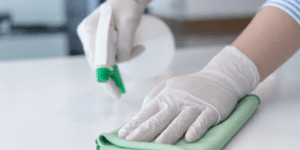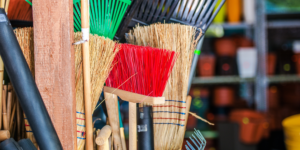blog
8 Ways to Keep Your Tools and Cleaning Clothes Clean
22 December 2023
We all know that the correct tools are necessary for any profession. But how about maintaining those tools? Remember those faithful cleaning rags that keep our spaces clean? Lack of upkeep can cause dull blades, rusted surfaces, and worn-out textiles, making each work harder. We’ll offer eight practical strategies to maintain your tools and cleaning clothing. We cover storage and upkeep.
The importance of keeping tools and cleaning clothes clean
Clean equipment and clothes may seem obvious, but they are crucial. Cleaning your tools prevents dirt, filth, and debris from accumulating. This prolongs their lives and functionality. Using a rusty screwdriver or clogged paintbrush is inefficient and frustrating!
Also, cleaning your tools regularly keeps them ready for use. The worst thing is reaching for a tool and finding sticky residue after its last use. Keep them clean to avoid project delays and catastrophes.


Care for your cleaning clothes is also crucial. These handy wipes remove dust, and stains, and shine our spaces. But if we don’t wash or store them, bacteria and mold can grow—yuck! Additionally, filthy cleaning cloths might spread dirt instead of eliminating it.
Proper storage techniques for tools
Maintaining tool effectiveness and lifetime requires proper storage. A messy workspace might lead to misplaced tools, which wastes time and increases damage or loss.
One useful method is to get a good toolbox or tool chest with drawers for different tools. You can categorize anything and find it easily. Foam inserts or custom-cut foam trays can also prevent tool movement during transit.
Cleaning tools before storing them is also necessary. After using a tool, wipe it down to remove dust and debris. This prevents corrosion and makes your tools ready to use when you need them.
Tools must be stored in a dry, temperature- and humidity-controlled environment. Moisture can corrode metal surfaces, reducing performance and risking harm.
Regular maintenance and cleaning tips for tools
Tools need regular cleaning and maintenance to last and perform well. Here are some tool maintenance tips.
Maintaining tool cleanliness after usage is crucial. Remove dirt, debris, and rust with a soft cloth or brush. A mild detergent or solvent formulated for your tool can remove tough stains and grime.
Tools should be completely dried before storage after cleaning. Over time, moisture causes corrosion and damage. Compressed air or a towel can remove moisture.
Also, check your tools for wear and tear. If handles fracture or splinter, replace them. Blades should be sharpened regularly to stay effective.
Keep cleaned and maintained instruments in a dry, organized place away from high temperatures and humidity. Toolboxes, pegboards, and wall-mounted racks are good storage options.
Choosing the right cleaning products for different materials
The correct cleaning chemicals for different materials are vital for tool and cleaning cloth lifetime and efficacy. Each material needs a specific cleaning to avoid damage or discoloration.
Use a non-corrosive degreaser or lubricant on metal instruments like wrenches and screwdrivers. Avoid severe rust- and erosion-causing chemicals.
Use mild soaps or multi-surface cleansers on plastic scrub brushes and dustpans. Hard chemicals can weaken plastic, causing breaking or distortion.
Use moderate detergents for sensitive fibers like microfiber cloths and chamois leather. Avoid bleach and fabric softeners, which degrade fibers and limit dust and particle trapping.
Broom and mop handles made of wood need specific care. Clean wood with wood-specific cleansers to avoid drying and cracking. A wax coating can also preserve their sheen and longevity.
How to properly wash and store cleaning clothes
Cleaning garments need proper care to last and work well. Some easy methods can keep your cleaning clothes in good shape.
Always read cleaning cloth care labels before washing. Materials need different handling. Some are machine-washable, others hand-wash or dry clean.
Wash cleaning cloths with a gentle detergent and avoid bleach and fabric softeners, which can harm the fibers. Separate them from other laundry to avoid soiling your clean clothes.
Rinse cloths thoroughly after washing to remove soap residue. A film from soap buildup limits absorbency and efficacy.
After cleaning, air drying is excellent for keeping cleaning cloth quality. Extreme tumble-drying heat can shrink or harm delicate materials.
Find a place to store cleaned and dried cleaning cloths that is accessible but dust-free. Cleaning supply storage bins or drawers may be useful.
Washing and keeping your cleaning clothes properly extends their lifespan and maintains their efficiency in domestic activities!
Alternative methods to keep tools and clothes clean
- Vinegar and Baking Soda: These household ingredients clean gadgets and clothes well. Natural metal cleaning vinegar and water eliminates dirt and grease. However, baking soda paste with water removes fabric stains.
- Lemon Juice: Lemon juice cleans tools due to its acidity. Wipe your tools with fresh lemon juice with a towel or sponge to eliminate dirt and rust.
- Steam cleaning is ideal for hard-to-reach regions or sensitive materials. No harsh chemicals are needed to clean and sanitize.
- Essential Oils: They smell fantastic and have antibacterial characteristics that clean tools. To disinfect naturally, mix a few drops of your preferred oil with water in a spray bottle.
- Sanding Blocks: Use them to remove sticky residue from tools. Rub the block against the surface to remove sticky muck without destroying the tool.
Use mesh bags to minimize lint buildup and damage to delicate fabrics when washing small items like cleaning clothes or microfiber towels in the washing machine.
- Use clothespins to store tiny tools like brushes and screwdrivers vertically on a wall or pegboard to keep things tidy and accessible.
- Use magnetic strips to store metal equipment on walls or drawers, saving space and ensuring easy access.
Explore these alternate methods to clean your tools and cleaning clothing. Utilize these cleaning methods to reap the benefits of a well-maintained toolbox.
Tips for organizing and decluttering your workspace
A messy desk can reduce productivity and make items hard to find. Keeping your tools and cleaning clothing clean requires a tidy workspace. Here are some starting tips.
Classify tools by function or kind. It will be easier to find them when needed. Store screws, nails, and brushes in labeled bins or drawers. Next, try pegboards or magnetic strips for wall storage. These can save counter space and keep your most-used tools close.
Assess your workspace objects often and decide if they’re necessary. If not, donate or dispose. Clutter-free spaces improve focus and productivity. Maintain excellent habits by organizing and clearing your workspace weekly or monthly, depending on usage.


Importance of regularly checking and replacing old or damaged tools
Cleaning tools are necessary, but they can wear out or break. For cleaning efficiency and safety, check and replace worn or damaged tools regularly.
Poorly maintained tools are inefficient. Frayed or missing bristles make brooms ineffective at sweeping away dirt. A worn-out mop head may leave streaks instead of cleaning the floor. By periodically examining and replacing worn equipment, you maximize cleaning outcomes.
Safety issues exist with old or broken tools. A vacuum cleaner handle that is cracked or broken may not provide sufficient control and could cause injury. Electric shocks and fires can also result from power tool electrical cable failure. Checking tools for wear and deterioration is crucial to safety.
Conclusion
Tool care and laundry are vital for their longevity and efficacy. By following these steps, you can keep your equipment clean, organized, and ready to use.
Tools are protected from corrosion and damage by toolboxes and pegboards. Lubricating metal parts or wiping surfaces after use will keep them in good condition. Cleaning with the proper products for different materials removes dirt and grime safely.
Clothes cleaning requires attention. Separating materials and using proper detergents help preserve their quality. Vinegar or baking soda can also erase tough stains.











